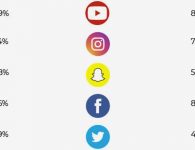
Today, AOL and Yahoo are near-worthless divisions of a phone company, as Verizon picks their digital bones to assimilate, sell off, or shut down what’s left. But two decades ago, AOL and Yahoo essentially were the internet, along with Microsoft Network (MSN). A new video shows just how this demise occurred—and how Google and YouTube came to dominate the internet—through an 8-minute bar graph that depicts how worldwide monthly traffic has evolved over nearly 24 years, starting in January 1996.
The video, which lives on a website that didn’t even exist at the time the animation starts, lives on the Data Is Beautiful YouTube channel, a collection of time-lapse statistics videos produced by a self-described “PhD student, data geek” features a mesmerizing .
As the video shows, AOL remains the undisputed superpower until early 2000, with about twice the traffic of its nearest rivals, Yahoo and MSN. (Below them are true ancient relics, like the online networks GeoCities, Excite, and Lycos.) This was the year that the dial-up king purchased media giant Time Warner—creating a $162 billion behemoth that was the largest entertainment conglomerate in the world up till then. (Today’s biggest is Walt Disney, according to Fortune’s rankings.)
Articles at the time referenced the company’s signature line “You’ve got mail”—also the name of a 1998 Meg Ryan-Tom Hanks romantic comedy that portrayed a Barnes and Noble type conglomerate as the greatest threat to mom and pop booksellers. (Amazon was just beginning its rise when the movie came out.)
But AOL had already hit its high-water mark when it bought Time Warner. By early 2001, Yahoo had eclipsed it in monthly visits, and AOL began a precipitous decline with only a few timid rallies over the years. Yahoo then looked like the Roman Empire of the internet—dominating with its web portal, email, and user groups for half a decade until Google stormed the gates. But Google’s dominance did not look inevitable in the late aughts, as it and Yahoo continually traded off the top-traffic title.
The modern era of the Internet starts to emerge in 2007 when YouTube and Facebook seem to come out of nowhere. YouTube was founded just three years earlier, but got a huge boost in 2006 when Google bought it for what seemed like a whopping $1.65 billion. (The New York Times reckons that YouTube generates at least 10 times as much money per year today.) Facebook began in 2004 as a network limited to college campuses. When it opened to the public in 2006, it quickly came to dominate the internet, as Myspace sunk into oblivion.
The Google-YouTube-Facebook triumvirate emerged way back in 2012. But while those sites remain on top in 2019, their relative power has changed. Facebook’s share of the net has been declining since mid-2014 as Google surges ahead. And its absolute numbers have dropped from about 28 billion monthly visits in late 2017 to a still-stunning over 23 billion this month. Google’s traffic, however, is over three times as big on its own, and nearly four and a half times the size if you count YouTube.
But as the visualization shows, no tech platform has dominated for the entire history of the internet. Ultimately, there is no guarantee that today’s biggest traffic destinations will remain on top.
read more at https://www.fastcompany.com by Sean Captain
Tech









